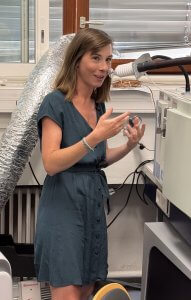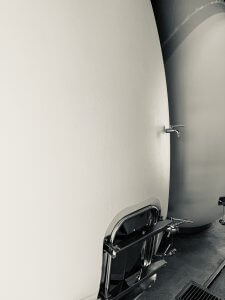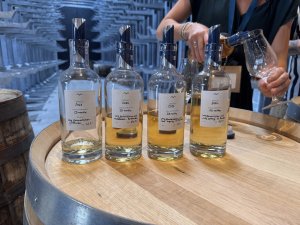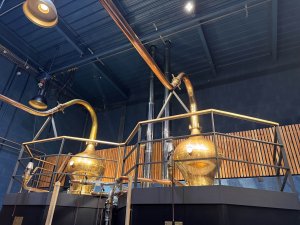Why saving Maison Lineti is important
I wrote about the remarkable Maison Lineti last year. Last week I was lucky enough to return, as owners Dr Magali Picard and her husband Alex Cosculluela hosted the 6th World Whisky Forum (of which more on Friday).
This gave me a chance of a deeper dive into the thinking behind a distillery whose aim is to bridge the worlds of fine wine and whisky. Would you expect anything less from a producer not only based in St.Emilion, but whose name is an anagram of the region?
They ask the question, what happens if you take proven wine techniques and apply them to whisky, to deepen the resonance of the spirit, to offer new possibilities for distillers. Magali splits her time between the distillery and her lab in the University of Bordeaux (itself a collaboration between her employer Demptos and the institution), where she applies analytical chemistry to discover what lies behind sensory character.
Lineti is science-based, but she is quick to say at the outset of our tour of the university labs, ‘it comes down to drinkability. We’re trying to elevate whisky through studying structure, quality and elegance.

Every aspect of whisky production is studied down, astonishingly, to atomic levels. ’What we do here is driven by R&D to quantify the atomic families, using sensory data, structural tasting and a deep dive into how precursors are formed. It’s important to isolate and identify the compounds and study how they interact,’ she adds. ‘All of this guides the distillery.’
Fermentation, ‘the cornerstone’, receives particular attention, as this is where the distiller (and winemaker) slowly layers together mouthfeel, length, tautness, and acidity. She speaks of distillation as being about ‘selection, not separation’ and the ‘kinetics of distillation,’ where the studies look at speed, temperature, and what happens when the heads and tails are recycled either into the wash or spirit distillation.
Much of her studies, first in wine and now in spirits, has revolved around oak: not only species, but seasoning, and treatment. ‘Oak charring, is important,’ she explains, ‘but what toast lies behind the char is more significant. What effect will that have on flavour? We examine all the parameters of new oak, and also evaluate refill dynamics, extract, oxidation.We go deep!’

As the physicist Richard Feynman said, ‘everything that living things do can be understood in terms of the jigglings and wigglings of atoms.’ Maison Lineti is revealing the dance of the elements, even the gaps between protons, to understand flavour.
One result of the investigations is the discovery that the first year of a spirit’s life in cask is the most important in building complexity. Also, if you barrel into new oak in summer you get more extract, so putting spirit into cask in winter is better.
‘Wood is a tool of expression, just as in wine,’ she says. ‘It shouldn’t be muddled or overpowering but used with precision to allow a slow, controlled release to help with soft mouthfeel, texture, and length.’

Later that day at the distillery, we taste the results of the fermentation trials: 29 month spirits all aged in American oak, but fermented in different ways in Maison Lineti’s ceramic eggs.
A ‘standard’ 7 day ferment has a hint of honey, flowers, great acidity and a sappy, green grassiness. Another has utilised the wine technique of ‘cold settling’ prior to ferment where the wort is clarified by dropping the temperature to 5˚C for 12 hours. It’s then filtered and the week-long ferment begins. This was more precise, distinctly more floral, but with a clarity and that desired tautness.
Adding lactic bacteria to another ferment added depth and roundness to the mouthfeel and a greater degree of subtlety but still with those clean acids.
Finally was one which had rested on its lees for 21 days after the week-long ferment. The shape of the eggs generates thermal currents. The impact of this flow is then amplified by another wine technique, pumping the lees from the base of the egg to the top, increasing the interaction. This sample had it all – greater length, increased soft mouthfeel, ripe fruits and layering. The practical application of the theoretical.
It’s easy to see the science, the machines, and the chemical compounds as coldly clinical, but these whiskies have soul. As Magali says, ‘I want to democratise this research. Biochemistry is drinkability.’
This is why the news that Alex and Magali’s majority shareholder had suddenly pulled out of the business, leaving them facing bankruptcy, is so shocking. The distillery closed, the dream shattered.

There are few genuine innovations in whisky. There are breakthroughs, techniques, new marketing ideas, but something which significantly changes the way whisky is either made or thought about is rare. Maison Lineti is genuinely innovative – and this is the time, when whisky is struggling, that innovation is vital. It offers a route out.
To speak with them is to have an insight into what whisky could be. To hear that the whole project is under threat is tragic.
The whisky world is going through challenging times at the moment and many worthy projects are on the brink, but Maison Lineti is different. It is different because it is important, vital even for whisky moving forward. It offers a glimpse of the future. It needs to be saved.
A business prospective is available. Contact alex.c@maison-lineti.com